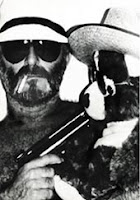ONE-MAN SHOWS
1988 Galerie Pierre Lescot, Paris, France
1989 Galerie Andy Jllien, Zurich, Switzerland
Galerie B&W, Oberüzwill, Switzerland
Galerie Graf & Schelble, Basel, Switzerland
1990 Galerie Eterso, Cannes, France
Galerie Art Actuel, Liège, Belgium
William Travor Gallery, seattle, USA
1991 Galerie de Bellecour, Lyon, France
Galerie Eterso, Cannes, France
TURIN ART FAIR, Italy (Galerie Eterso)
Galerie Agora, Marseille, France
Galerie Lilo Marti, Saint-Paul-de-Vence, France
Chapelle des Pénitents Blancs, Vence, France
1992 Galerie Graf & Schelble, Basel, Switzerland
SALON DES DÉCOUVERTES, Paris, France (Galerie Eterso)
Galleria Millennium, Milan, Italy
1993 Gallery Art Today, Milwaukee, USA
Galerie Pascal Polar, Brussels, Belgium
FIAC ART FAIR, Paris, France (Galerie Pascal Polar)
1994 Galerie Graf & Schelble, Basel, Switzerland
Galerie Heinrich Schmidt, Grenzach, Germany
ART ’94 BASEL, Switzerland (Galerie Pascal Polar)
1995 Galeria Ferran Cano, Barcelona, Spain
Galeria Ferran Cano, Palma di Mallorca, Spain
1996 CHICAGO ART FAIR, USA (Galerie Pascal Polar)
1997 ART COLOGNE, Germany (Gal. Pascal Polar / Graf & Schelble)
Galerie Eterso, Paris, France
1998 Galerie Lilo Marti, Saint-Paul-de-Vence, France
1999 Galerie Graf & Schelble, Basel, Switzerland
GROUP EXHIBITIONS AND INTERNATIONAL ART FAIRS
1989 Biennale de Cannes, France (Galerie Eterso)
1990 Foire de l’Art, Ghent, Belgium (Galerie Eterso)
Espace Interrogation, Toulon, France
1991 Bologna Art fair, Italy (Galerie Eterso)
Art Jonction, Nice, France (Galerie Eterso)
1992 Musée Ingres, Montauban, France
1994 Biennale du Papier, Stadstbestuur Aalst, Belgium (Galerie Pascal Polar)
1995 Autour du Papier, Angers, France
1996 Galerie Lilo Marti, Saint-Paul-de-Vence, France
Carl Schlosberg Fine Arts, Malibu, USA
1999 Château d’Apricale, Italy
2001 Paper Revisioned, Art Center, Silkeborg Bad, Denmark
2002 Galerie Joël Scholtès, Nice, France
Artupstairs, Easthampton, NY, USA
2004 Galerie Evelyne Palud Berger, Saint-Jean-Cap-Ferrat, France
2006 Galerie Pascal Polar, Bruxelle, Belgique

